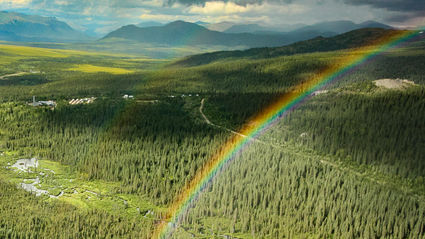Bornite resource holds steady, for now
North of 60 Mining News – March 22, 2019
Last updated 9/25/2020 at 2:23pm

Shane Lasley
A rainbow touches down at Bornite, a carbonate hosted deposit in Alaska's Ambler Mining District that hosts roughly 6.4 billion pounds of copper and 77 million lb of cobalt.
Trilogy Metals Inc. March 19 reported that much of the step-out drilling completed over the past two years is still too widely spaced to result in a significant increase in resources at this large copper deposit on the company's Upper Kobuk Mineral Projects in Northwest Alaska.
At a cut-off grade of 0.5 percent, the open-pit portion of Bornite hosts 40.5 million metric tons of indicated resource averaging 1.02 percent (913 million pounds) copper; and 84.1 million metric tons of inferred resource averaging 0.95 percent (1.77 billion lb) copper.
At the same cut-off grade, the Bornite open-pit also hosts 124.6 million metric tons of inferred resource averaging 0.017 percent (45 million lb) cobalt.
At a cut-off grade of 1.5 percent, the below-pit portion of Bornite hosts 57.8 million metric tons of inferred resource averaging 2.89 percent (3.68 billion lb) copper and 0.25 percent (32 million lb) cobalt.
The 2018 technical report shows that lowering the below-pit cut-off grade of 0.5 percent significantly increases the amount of copper and cobalt in the inferred resource, though at a much lower grade.
At a cut-off grade of 0.5 percent, the below-pit portion of Bornite hosts 238.1 million metric tons of inferred resource averaging 1.35 percent (7.08 billion lb) copper and 0.015 percent (78 million lb) cobalt.
This lower cut-off grade, however, is typically below the threshold for most standard underground mining techniques.
A preliminary economic assessment, expected to be initiated following the 2019 work program, will take a closer look at the various cut-off grades and mining techniques for Bornite, which could include the look at a larger open-pit to capture more of the lower grade copper and cobalt.
The US$9.2 million work program budgeted for Bornite this year, being funded by South 32 Ltd., will include approximately 10,000 meters of infill and expansion drilling in 12 holes; additional metallurgical work to optimize copper recoveries and the determination of next steps for the recovery of cobalt; and initial engineering studies to prepare Bornite for a PEA once the work from the 2019 work programs are completed.
This economic assessment is expected to include the new results from the metallurgical program as well as a resource update for Bornite.
Arctic feasibility
The 2019 program will also include a US$7 million program, funded by Trilogy, that will include engineering and environmental work needed to support the completion of a feasibility study for Arctic, a rich volcanogenic massive sulfide project about 16 miles north of Bornite.
Arctic hosts 43.04 million metric tons of probable reserves averaging 2.32 percent copper, 3.24 percent zinc, 0.57 percent lead, 0.49 grams per metric ton gold and 36 g/t silver.
A prefeasibility study published in 2018 details plans for an open-pit mine at Arctic and a 10,000-metric-ton-per-day mill that would churn out more than 159 million lb of copper, 199 million lb of zinc, 33 million lb of lead, 30,600 ounces of gold and 3.3 million oz of silver annually over a 12-year mine life.
This summer's work at Arctic will include additional hydrological and geotechnical work at the site, along with water management, tailings facility and waste rock containment analysis and design.
Additional metallurgical test work to verify ore hardness and grinding characteristics is currently underway.
Trilogy expects to complete the Arctic feasibility study in the first half of 2020.
Ambler VMS Belt exploration
In addition to advancing Bornite and Arctic, Trilogy will carry out a US$2 million exploration program, funded equally by Trilogy and South32, that will investigate some of the other VMS deposits and targets along the 60-mile (100 kilometers) Ambler Belt.
This program will include district-wide VTEM (versatile time domain electromagnetic) and ZTEM (z-axis tipper electromagnetic) geophysical surveys flown on 200- and 400-meter line spacing over both the Cosmos Hills, which host Bornite, and the Ambler Belt, which hosts Arctic.
Both electromagnetic surveys have proven to be successful in identifying targets and mineralization in VMS districts.
These geophysical surveys are expected to be completed by early May and the information will be used to identify and prioritize targets.
Follow-up work will include geologic mapping, soil geochemistry and drilling – including on known historic resources previously identified along the Ambler Belt.
"It is exciting to be drilling new exploration targets again," Trilogy Metals President and CEO Rick Van Nieuwenhuyse said earlier this year. "We are confident that we can find additional high-grade polymetallic resources along this prolific mineral belt."
–SHANE LASLEY
CORRECTION: This article was update on July 3, 2019 to correct the Bornite open-pit inferred and indicate resource categories.















Reader Comments(0)